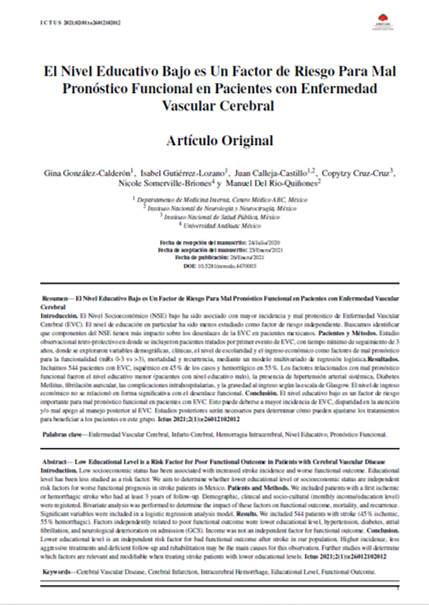Abstract
ABSTRACT
Introduction
Low socioeconomic status has been related to increased stroke incidence and bad functional outcome. Educational level has been less studied as a risk factor. We aim to determine if lower educational level or socioeconomic status are independent risk factors for worse prognosis in stroke patients in Mexico.
Methods
We included patients with a first ischemic or hemorrhagic stroke who had at least 3 years of follow-up. Demographic, clinical and socio-cultural (income/highest education level) variables were registered. Bivariate analysis was performed to determine the impact of these factors on functional outcome, mortality, and recurrence. The resultant sariables were included in a logistic regression analysis model.
Results
We included 544 patients with stroke (45% ischemic, 55% hemorrhagic). Factors independently related to poor functional outcome were lower educational level, HTM, DM, AF, and neurological deterioration on admission (GCS). Income and lower educational level were not independent predictor for recurrence or mortality.
Conclusion
Lower educational level an independent risk factor for bad functional outcome after stroke in our population. Higher incidence, less aggressive treatments and deficient follow-up and rehabilitation may be the main causes for this observation. Further studies will determine which factors are relevant and modifiable when treating stroke patients with lower educational levels.
References
Carandang R, Beiser A, Kelly-hayes M, Kase CS, Kannel WB, Wolf P a. Trends in Incidence, Lifetime Risk, Severity, and 30-Day Mortality of Stroke Over the Past 50 Years. 2014;296(24):2939–46. DOI: 10.1001/jama.296.24.2939
Johnson CO, Nguyen M, Roth GA, Nichols E, Alam T, Abate D, et al. Global, regional, and national burden of stroke, 1990–2016: a systematic analysis for the Global Burden of Disease Study 2016. Lancet Neurol [Internet]. 2019 [citado el 15 de julio de 2020];18(5):439–58. Disponible en: http://dx.doi.org/10.1016/
Lloyd-sherlock P. Stroke in Developing Countries : Epidemiology , Impact and Policy Implications. 2010;28(6):693–709. DOI: 10.1111/j.1467-7679.2010.00505.x
Chang CL, Marmot MG, Farley TMM, Poulter NR. The influence of economic development on the association between education and the risk of acute myocardial infarction and stroke. J Clin Epidemiol. 2002;55(8):741–7. https://doi.org/10.1016/S0895-4356(02)00413-4
Olascoaga Arrate A, Freijo Guerrero M del M, Fernández Maiztegi C, Azkune Calle I, Silvariño Fernández R, Fernández RodrÃguez M, et al. Relación del nivel de estudios con la supervivencia en el primer año tras un ictus isquémico. Rev Neurol. 2019;68(04):147. https://doi.org/10.33588/rn.6804.2018254pen
Agarwal S, Menon V, Jaber WA. Outcomes after acute ischemic stroke in the United States: does residential ZIP code matter? J Am Heart Assoc. 2015;4(3):e001629. https://doi.org/10.1161/JAHA.114.001629
Vivanco-Hidalgo RM, Ribera A, Abilleira S. Association of socioeconomic status with ischemic stroke survival. Stroke. 2019;50(12):3400–7. https://doi.org/10.1161/STROKEAHA.119.026607
Morovatdar N, Thrift AG, Stranges S, Kapral M, Behrouz R, Amiri A, et al. Socioeconomic Status and Long-Term Stroke Mortality, Recurrence and Disability in Iran: The Mashhad Stroke Incidence Study. Neuroepidemiology. 2019;53(1–2):27–31. https://doi.org/10.1159/000494885
Marshall IJ, Wang Y, Crichton S, McKevitt C, Rudd AG, Wolfe CDA. The effects of socioeconomic status on stroke risk and outcomes. Lancet Neurol [Internet]. 2015;14(12):1206–18. Disponible en: http://dx.doi.org/10.1016/S1474-4422(15)00200-8
Bray BD, Paley L, Hoffman A, James M, Gompertz P, Wolfe CDA, et al. Socioeconomic disparities in first stroke incidence, quality of care, and survival: a nationwide registry-based cohort study of 44 million adults in England. Lancet Public Heal [Internet]. 2018;3(4):e185–93. Disponible en: http://dx.doi.org/10.1016/S2468-2667(18)30030-6. https://doi.org/10.1016/S2468-2667(18)30030-6
Savio K, Pietra GL Della, Oddone E, Reggiani M, Leone MA. Reliability of the modified Rankin Scale applied by telephone. Neurol Int. febrero de 2013;5(1):e2–e2. https://doi.org/10.4081/ni.2013.e2
Baggio JAO, Santos-Pontelli TEG, Cougo-Pinto PT, Camilo M, Silva NF, Antunes P, et al. Validation of a Structured Interview for Telephone Assessment of the Modified Rankin Scale in Brazilian Stroke Patients. Cerebrovasc Dis. 2014;38(4):297–301. https://doi.org/10.1159/000367646
AMAI. Niveles de ingreso [Internet]. [citado el 27 de julio de 2020]. Disponible en: https://www.economia.com.mx/niveles_de_ingreso.htm
Kuper H, Adami HO, Theorell T, Weiderpass E. The socioeconomic gradient in the incidence of stroke: A prospective study in middle-aged women in Sweden. Stroke. 2007;38(1):27–33. https://doi.org/10.1161/01.STR.0000251805.47370.91ll
Bettger JP, Zhao X, Bushnell C, Zimmer L, Pan W, Williams LS, et al. The association between socioeconomic status and disability after stroke: Findings from the Adherence eValuation After Ischemic stroke Longitudinal (AVAIL) registry. BMC Public Health. 2014;14(1):1–8. https://doi.org/10.1186/1471-2458-14-281
McHutchison CA, Backhouse E V., Cvoro V, Shenkin SD, Wardlaw JM. Education, Socioeconomic Status, and Intelligence in Childhood and Stroke Risk in Later Life: A Meta-analysis. Epidemiology. 2017;28(4):608–18. https://doi.org/10.1097/EDE.0000000000000675
Pennlert J, Asplund K, Glader EL, Norrving B, Eriksson M. Socioeconomic Status and the Risk of Stroke Recurrence: Persisting Gaps Observed in a Nationwide Swedish Study 2001 to 2012. Stroke. 2017;48(6):1518–23. https://doi.org/10.1161/STROKEAHA.116.015643
Fernandes TG, Goulart AC, Santos-Junior WR, Alencar AP, Benseñor IM, Lotufo PA. Educational levels and the functional dependence of ischemic stroke survivors. Cad Saude Publica. 2012;28(8):1581–90. https://doi.org/10.1590/s0102-311x2012000800016
Skidmore ER, Whyte EM, Holm MB, Becker JT, Butters MA, Dew MA, et al. Cognitive and Affective Predictors of Rehabilitation Participation After Stroke. Arch Phys Med Rehabil. 2010;91(2):203–7. https://doi.org/10.1016/j.apmr.2009.10.026
Hartman-Maier A, Soroker N, Ring H, Katz N. Awareness of deficits in stroke rehabilitation. J Rehabil Med. 2002;34(4):158–64. https://doi.org/10.1080/16501970213236

This work is licensed under a Creative Commons Attribution 4.0 International License.
Copyright (c) 2021 Ictus

